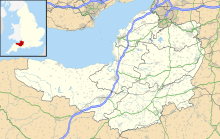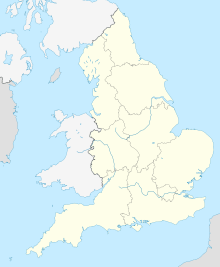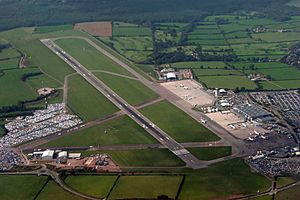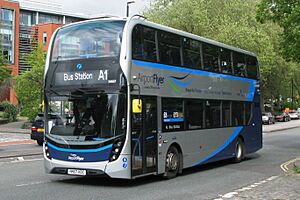Bristol Airport facts for kids
Quick facts for kids
Bristol Airport
|
|||||||||||
|---|---|---|---|---|---|---|---|---|---|---|---|
 |
|||||||||||
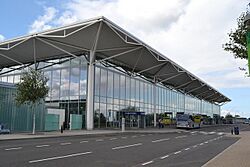 |
|||||||||||
| Summary | |||||||||||
| Airport type | Public | ||||||||||
| Owner | Ontario Teachers' Pension Plan | ||||||||||
| Serves | Bristol and West of England | ||||||||||
| Location | Lulsgate Bottom, North Somerset | ||||||||||
| Focus city for | |||||||||||
| Elevation AMSL | 622 ft / 190 m | ||||||||||
| Coordinates | 51°22′58″N 002°43′09″W / 51.38278°N 2.71917°W | ||||||||||
| Map | |||||||||||
| Runway | |||||||||||
|
|||||||||||
| Statistics (2024) | |||||||||||
|
|||||||||||
Bristol Airport (BRS/EGGD) is an international airport located near Bristol, England. It serves Bristol and the surrounding areas. The airport is about 7 miles (11 km) southwest of Bristol city centre. It was built on the site of a former RAF airfield and opened in 1957. It was first called Bristol (Lulsgate) Airport. From 1997 to 2010, it was known as Bristol International Airport.
In 2019, Bristol Airport was the eighth busiest airport in the United Kingdom. It handled over 8.9 million passengers that year. In 2024, it served over 10.4 million passengers. Many passengers come from Bristol, Gloucestershire, Somerset, Devon, and Wiltshire.
Airlines like easyJet and Ryanair have main bases at Bristol Airport. The airport has a special licence from the Civil Aviation Authority. This licence allows it to operate flights for public passengers and for flying lessons.
Airport History: From Past to Present
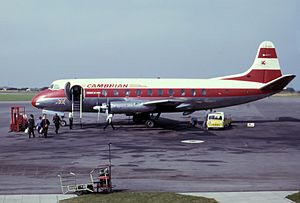
Bristol's First Airport
Bristol's first airport was at Whitchurch. It opened in 1930 and was one of the first civil airports in the UK. By 1939, it served 4,000 passengers.
During World War II, Whitchurch was a very important airport. The British Overseas Airways Corporation (BOAC) used it for flights across the British Empire. Even Winston Churchill flew from Bristol during the war.
RAF Lulsgate Bottom: A Wartime Airfield
In 1940, a relief landing ground was set up at Lulsgate Bottom. This area was high up, which was useful when lower airfields were foggy. In 1941, work began to turn it into a proper airfield for fighter planes. It was named RAF Lulsgate Bottom.
The airfield was used for training pilots and for anti-aircraft defence exercises. BOAC also used it for training crews and as a backup for Whitchurch. The RAF stopped using Lulsgate in 1946 after the war ended.
Becoming Bristol (Lulsgate) Airport
After the war, the Whitchurch airport needed a longer runway for bigger planes. But it was hard to expand because of nearby houses. So, in 1955, Bristol Corporation bought the Lulsgate airfield.
The city spent money to build a new terminal and other facilities. In April 1957, all flights moved from Whitchurch to the new airport. It was officially opened on May 1, 1957, as Bristol (Lulsgate) Airport. In its first year, 33,000 people used it.
Over the years, the airport grew. A new control tower was built in 1962. The runway was made longer in 1969. By 1980, the airport was losing money. However, with new management, it became profitable again by 1981. In 1984, a new international departure lounge was added.
In 1987, the airport became a public company, Bristol Airport plc. The city council still owned it. In 1994, plans for a new terminal were approved. To help fund these big projects, the council sold a majority share of the airport.
Bristol International Airport Era
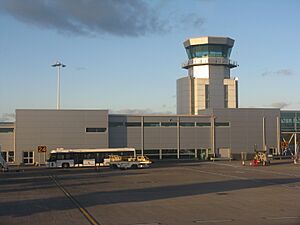
In 1997, the airport changed its name to Bristol International Airport. A company called FirstBus bought a 51% share. The new terminal building opened in March 2000. It cost £27 million. In 2000, over two million passengers used the airport for the first time.
In 2001, the airport was sold to a joint venture of Macquarie Bank and Cintra. Later, the Ontario Teachers' Pension Plan became the sole owner in 2014.
Low-cost airlines like Go Fly and easyJet helped passenger numbers grow quickly. In 2002, over three million passengers used the airport. Ryanair also set up a base here in 2007. By 2008, passenger numbers reached six million.
A new runway surface was laid between 2006 and 2007. In 2010, the airport was rebranded simply as Bristol Airport. It got a new logo and slogan: "Amazing journeys start here."
Bristol Airport does not use jetways. This means passengers walk to their planes or take a bus. In 2010, a long walkway was built to reduce the need for buses. In 2020, Jet2.com and Jet2holidays announced Bristol would be their tenth UK base. Flights started in July 2021.
Airport Expansion and Future Plans
Bristol Airport has plans to grow and serve more passengers.
Early Expansion Plans
In 2003, the airport shared a Master Plan for expansion until 2030. This plan aimed to increase passenger numbers to 10 million per year. The plan was approved in 2010.
The expansion included many projects. These involved:
- Doubling the size of the passenger terminal.
- Adding new areas for planes to park.
- Building multi-storey car parks.
- Creating a public transport hub.
The first new aircraft stands were finished in 2012. A new walkway to the terminal opened in 2014. In 2015, an extension to the departure lounge was completed. A new security area with 12 lanes opened in 2016. The immigration hall was also expanded in 2017. A new multi-storey car park opened in 2018.
On-site Hotel
In 2010, plans for a hotel at the airport were approved. The 201-room hotel, operated as a Hampton by Hilton, opened in January 2017. It was built using prefabricated parts shipped from China.
Recent Expansion Proposals
In 2018, the airport proposed another expansion. This plan aimed to allow 12 million passengers per year. It included enlarging the terminal and adding parking for 3,000 more cars. Much of this parking would be on greenbelt land.
Many local people and groups opposed this plan. In February 2020, the North Somerset council rejected it. They felt the negative effects on the environment outweighed the benefits.
The airport appealed this decision. After a public inquiry, the appeal was granted in February 2022. Local groups tried to challenge this in the High Court and the Court of Appeal, but their challenges were dismissed. This meant the airport could go ahead with its plans.
In September 2023, Bristol Airport began its expansion work. This started with a £60 million transport hub and car park. This project will create one of the region's largest bus interchanges on the top level of the new car park. It will increase bus and coach bays from 6 to 16. The new car park will also have over 2,000 parking spaces. This project is expected to take 18 months.
In November 2024, the airport started a new consultation for even more expansion. This includes plans for direct long-haul flights to places like the Middle East and the East Coast of America. They also want to increase capacity to 15 million passengers per year. The proposal involves making the terminal much larger. It also includes a 150-meter runway extension and new taxiways to reduce congestion.
Some groups, like the Bristol Airport Action Network, are against these new plans. They say the airport doesn't consider local needs or its climate impact. However, others, like Steve Smith, a Conservative candidate, support the expansion. They believe it will create jobs and offer more travel options for local people.
Airport Facilities
Bristol Airport has one runway, called 09/27. The main direction used is runway 27, about 70% of the time. It is one of the shorter international airport runways in the UK, at 2,011 meters (6,598 feet) long. Despite its length, it can handle large aircraft like the Boeing 787 Dreamliner and Airbus A330.
Airlines and Destinations
Many airlines fly from Bristol Airport to various destinations. Here are some of the airlines and places they fly to:
| Airlines | Destinations |
|---|---|
| Aer Lingus | Cork, Dublin |
| Aurigny | Guernsey |
| Blue Islands | Jersey |
| easyJet | Agadir, Alicante, Almería, Amsterdam, Antalya, Athens, Barcelona, Basel/Mulhouse, Belfast–City, Belfast–International, Berlin, Bilbao, Bordeaux, Copenhagen, Edinburgh, Enfidha, Faro, Fuerteventura, Funchal, Geneva, Gibraltar, Glasgow, Gran Canaria, Hurghada, Inverness, Isle of Man, Istanbul, Kraków, Lanzarote, Larnaca, Lisbon, Madrid, Málaga, Marrakesh, Milan–Malpensa, Munich (begins 26 October 2025), Murcia, Newcastle upon Tyne, Nice, Palma de Mallorca, Paphos, Paris–Charles de Gaulle, Pisa, Porto, Prague, Rome–Fiumicino, Sharm El Sheikh, Tenerife–South, Toulouse, Venice, Zurich (begins 29 October 2025) Seasonal: Bodrum, Catania, Chania, Corfu, Dalaman, Dubrovnik, Grenoble, Heraklion, Ibiza, Innsbruck, Kos, La Rochelle, Lyon, Malta, Marseille, Menorca, Naples, Olbia, Palermo, Preveza/Lefkada, Pula, Reykjavík–Keflavík, Rhodes, Rovaniemi, Salzburg, Santorini, Skiathos, Split, Tivat, Tromsø, Turin, Verona (begins 6 December 2025), Vienna (begins 21 November 2025), Zakynthos |
| Edelweiss Air | Seasonal: Zurich |
| Jet2.com | Agadir, Alicante, Antalya, Faro, Fuerteventura, Funchal, Gran Canaria, Lanzarote, Málaga, Malta, Tenerife–South Seasonal: Almería, Berlin (begins 27 November 2025), Bodrum, Burgas, Chambéry, Chania, Corfu, Dalaman, Gdańsk (begins 28 November 2025), Geneva, Girona, Heraklion, Ibiza, Innsbruck, Izmir, Kalamata, Kefalonia, Kos, Larnaca, Menorca, Palma de Mallorca, Paphos, Prague, Preveza/Lefkada, Reus, Reykjavík–Keflavík, Rhodes, Skiathos, Thessaloniki, Verona, Vienna, Zakynthos |
| KLM | Amsterdam |
| Loganair | Aberdeen |
| Pegasus Airlines | Istanbul–Sabiha Gökçen |
| Ryanair | Alicante, Barcelona, Bergamo, Bucharest–Otopeni, Budapest, Bydgoszcz, Copenhagen, Dublin, Faro, Gran Canaria, Kaunas, Kraków, Lanzarote, Madrid, Málaga, Porto, Poznań, Riga, Rzeszów, Sofia, Tenerife–South, Toulouse, Venice, Wrocław Seasonal: Bergerac, Béziers, Fuerteventura, Gdańsk, Girona, Grenoble, Ibiza, Knock, Limoges, Marseille, Palma de Mallorca, Prague, Turin, Valencia |
| SunExpress | Antalya |
| TUI Airways | Fuerteventura, Gran Canaria, Hurghada, Lanzarote, Sal, Sharm El Sheikh, Tenerife–South Seasonal: Antalya, Burgas, Chambéry, Corfu, Dalaman, Dubrovnik, Heraklion, Ibiza, Innsbruck, Kefalonia, Kittilä, Kos, Larnaca, Málaga, Marrakesh, Menorca, Palma de Mallorca, Paphos, Reus, Rhodes, Rovaniemi, Salzburg, Skiathos, Thessaloniki, Toulouse, Turin, Verona, Zakynthos |
Airport Statistics: Passengers and Flights
This table shows how many passengers and flights Bristol Airport has handled over the years.
| Number of passengers |
Number of movements |
|||
|---|---|---|---|---|
| 1997 | 1,614,837 | 59,547 | ||
| 1998 | 1,838,219 | 61,582 | ||
| 1999 | 1,993,331 | 62,072 | ||
| 2000 | 2,141,525 | 63,252 | ||
| 2001 | 2,694,464 | 69,854 | ||
| 2002 | 3,445,945 | 72,152 | ||
| 2003 | 3,915,072 | 74,635 | ||
| 2004 | 4,647,266 | 77,956 | ||
| 2005 | 5,253,752 | 84,289 | ||
| 2006 | 5,757,963 | 84,583 | ||
| 2007 | 5,926,774 | 76,428 | ||
| 2008 | 6,267,114 | 76,517 | ||
| 2009 | 5,642,921 | 70,245 | ||
| 2010 | 5,747,604 | 69,134 | ||
| 2011 | 5,780,746 | 66,179 | ||
| 2012 | 5,921,530 | 61,206 | ||
| 2013 | 6,131,896 | 65,299 | ||
| 2014 | 6,339,805 | 64,230 | ||
| 2015 | 6,786,790 | 68,074 | ||
| 2016 | 7,610,780 | 73,536 | ||
| 2017 | 8,239,250 | 76,199 | ||
| 2018 | 8,699,529 | 72,927 | ||
| 2019 | 8,964,242 | 69,434 | ||
| 2020 | 2,194,524 | 29,191 | ||
| 2021 | 2,087,772 | 32,278 | ||
| 2022 | 7,948,941 | 56,391 | ||
| 2023 | 9,911,879 | 68,718 | ||
| 2024 | 10,479,112 | 78,554 | ||
| Source: UK Civil Aviation Authority | ||||
Busiest Routes from Bristol (2022)
This table shows the most popular flight routes from Bristol Airport in 2022.
| Rank | Airport | Total passengers |
Change 2021 / 22 |
|---|---|---|---|
| 1 | Alicante | 361,324 | |
| 2 | Dublin | 351,152 | |
| 3 | Palma de Mallorca | 350,929 | |
| 4 | Amsterdam | 349,096 | |
| 5 | Málaga | 316,799 | |
| 6 | Edinburgh | 296,617 | |
| 7 | Tenerife–South | 295,418 | |
| 8 | Faro | 290,858 | |
| 9 | Glasgow | 290,662 | |
| 10 | Belfast–International | 251,256 |
Getting to Bristol Airport: Transport Options
By Road
Bristol Airport is located on the A38, about 8 miles (13 km) southwest of Bristol city centre. You can find signs for the airport from the M5 motorway. A new road, the South Bristol Link Road, opened in 2017. This road helps connect the airport better to the M5.
By Bus
Several bus services connect the airport to different areas:
- The Airport Flyer (A1 service) links the airport to Bristol Temple Meads railway station and Bristol bus station.
- The A4 'Air Decker' service connects the airport with southern Bristol, Keynsham, and Bath.
- The 'South West Falcon' service runs between Bristol and Plymouth, stopping at the airport.
- Service 216 connects the airport to Newport and Cardiff.
- The WESTlink on-demand bus also serves the airport.
The airport is also a stop on the National Express coach network. As part of the airport's expansion, a new bus interchange is being built on top of a multi-storey car park. This will greatly increase the number of bus and coach bays.
Proposed Rail Link
There have been discussions about building a rail link to the airport. This would improve transport connections for passengers. By 2019, this idea had grown into a plan for a mass transit line.
General Aviation at Bristol Airport
Bristol Airport is also a hub for general aviation (GA). This means it handles smaller private planes and business jets. In 2006, a special terminal was built for GA aircraft.
Bristol Flying Centre manages services for visiting business jets. They also offer engineering services and operate their own business jets. The Bristol and Wessex Aeroplane Club manages services for lighter GA aircraft.
In 2012, Bristol Flying Centre made its terminal twice as big. This added new security facilities and passenger lounges. After Bristol Filton Airport closed in 2012, Bristol Airport took on more business jet traffic. In 2014, a new building called The Bristol Flying School was built. It houses the Bristol & Wessex Aeroplane Club and a flying school.
Incidents at Bristol Airport
- On January 19, 1970, a Vickers Viscount plane was badly damaged during a hard landing.
- On September 15, 2006, an easyJet Airbus A319 had a major electrical problem over France. It landed safely at Bristol Airport.
- On October 3, 2010, a Thomson Airways Boeing 767 landed very heavily in bad weather. No one was hurt.
- On December 22, 2017, a BMI Regional Embraer ERJ145 plane went off the runway after landing. No one was injured. This incident caused many flights to be sent to other airports.
See also
 In Spanish: Aeropuerto Internacional de Bristol para niños
In Spanish: Aeropuerto Internacional de Bristol para niños


